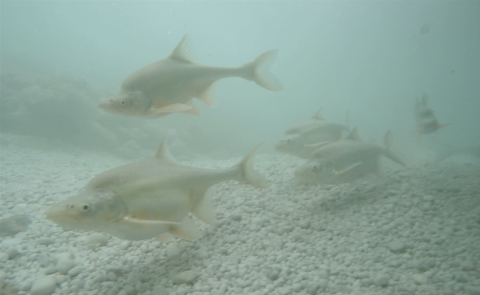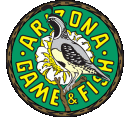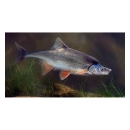Location
States
ArizonaEcosystem
River/streamIntroduction
Grand Canyon National Park is home to several unique species of native fishes. Historically, this assemblage included three abundant native species of chub, which resided within the seasonally warm, swift, and turbid Colorado River and tributaries that flow through the Canyon’s steep walls. Because they occupy canyon-bound rivers in isolated, rugged terrain, the Humpback Chub (Gila cypha) was the last native Colorado River fish species formally described by scientists in 1946. The Humpback Chub was listed as Endangered in 1967, but is the only remaining species of chub found in Grand Canyon National Park.
Humpback Chub belong to the minnow family and are known for their emblematic and distinctive hump shape behind their head. A few theories for this shape include coevolution for predator avoidance or swimming ability in swift-waters, although neither are definitive. Humpback Chub spawn from May through July in water temperatures that range from 57-75 ℉, and prefer spawning habitat of mixed boulders, gravel, and sand. Their eggs are highly sensitive to water temperatures, with the greatest chance for hatching and survival around 68 ℉. Before extensive habitat modification in the 20th century, adult Humpback Chub were suspected to live upwards of 30 years and reach 20 inches in length. Yet, current populations have declined in response to these changing flow, temperature, and habitat conditions.
Currently, Humpback Chub are still present in six regions, or population centers, of the Colorado River Basin including in Utah and Arizona. Grand Canyon National Park in Arizona contains the largest of the six remaining populations. Further, Grand Canyon is an epicenter for conservation efforts as the confluence of the Little Colorado River within the park contains the only known self-sustaining population, with biologists estimating between 10-12,000 fish here. To protect this species, fishery biologists and park managers from the Native Fish Ecology and Conservation Program in Grand Canyon National Park are taking a holistic approach to expand their abundance and distribution within the park.
Key Issues Addressed
Humpback chub populations in Grand Canyon National Park have been drastically reduced due to changing environmental conditions and habitat loss from hydroelectric dam construction and water withdrawals. This particularly includes Glen Canyon Dam, completed in 1966, located just north of Grand Canyon National Park.
Several key hydrological factors have adversely impacted populations of Humpback Chub downstream of Glen Canyon Dam. For example, cooler annual stream temperatures from water releases by Glen Canyon Dam, particularly during the summer, can influence the timing, physiology, and success of spawning adults.Yet, historically the Colorado River was near freezing in winter, and Humpback Chub had a high tolerance for temperature swings. In addition, more consistent annual flows in the Colorado River, controlled by regulated water releases, reduce habitat availability for backwater environments. These more temperate, nursery-like waters are essential for young Humpback Chub growth and survival. Less turbidity in cool, clear water released by dams also increases the vulnerability of young chub to predation.
Historically turbid conditions due to high-gradient streams protected young chub from natural predators such as the Colorado Pikeminnow (Ptychocheilus lucius). Introduced Brown Trout (Salmo trutta) and Rainbow Trout (Oncorhynchus mykiss), which are sight predators, are better equipped for cool, clear water, and outcompete native chub. Low population numbers of Humpback Chub, which rely on limited suitable habitat for reproduction (i.e., few spawning locations), reduce population redundancy, which in turn decreases this species’ resilience to future ecological disturbances.
Project Goals
- Establish self-sustaining populations of native Humpback chub in Grand Canyon National Park to expand their range and improve population redundancy
- Translocate Humpback Chub from an existing self-sustained population at Little Colorado River to three Colorado River tributaries: Shinumo, Havasu, and Bright Angel Creeks
- Decrease Humpback Chub predation and competition by non-native trout
Project Highlights
Translocation Success. Growth rates and survival of juvenile Humpback Chub in Havasu Creek have been equal to or greater than in the source population from the Little Colorado River.
- Prioritizing Grand Canyon Tributaries: Widespread baseline surveys were conducted to determine tributaries with suitable conditions for Humpback Chub. Criteria evaluated by project biologists included existing fish populations (both native and non-native), water quality, stream temperature and flow, fish barriers (either manmade or natural such as a waterfall) to control non-native fish, and proximity to the wild population in the Little Colorado River.
- Moving Humpback Chub: Young chub were captured as fingerlings during early summer (pre-monsoon) from the Little Colorado River source population, reared in a hatchery for 8-12 months until they reach approximately four inches in length, then flown by helicopter to their new homes the following spring or summer. Prior to arrival, chub were implanted with a PIT tag for a unique identification number and acclimated to the creek water before their release.
- Shinumo and Havasu Creeks Translocations: 302 chub were first relocated to Shinumo Creek in 2009, followed by 300 in 2010, 300 in 2011, and 200 in 2013, as well as several hundred more in Havasu Creek from 2011-2016. These tributaries may provide additional spawning grounds for adult chub as well as nursery habitat for young chub. They also promote more opportunities for young chub to grow, increasing their chances for survival when they move to the mainstem Colorado River.
- Trout Removal and Chub Translocations in Bright Angel Creek: Non-native Rainbow trout removal was conducted via fishing and electrofishing in Shinumo Creek before chub were introduced. In conjunction with identifying suitable habitat conditions, non-native Brown and Rainbow Trout were removed before expanding Humpback chub translocations to Bright Angel Creek in 2018. Trout were suppressed by 90% while native fish increased by over 400%. Visit this CART Case Study for more information on non-native trout removal in Bright Angel Creek.
Lessons Learned
While Humpback Chub translocation attempts have been made within the mainstem Colorado River, translocations in Grand Canyon National Park tributaries have been uniquely successful. Relative to other tributaries in the Southwest, Grand Canyon tributaries, like those featured in this project, have mostly natural, or unaltered, flows that are similar to conditions before hydroelectric dam development. Within the mainstem Colorado River, biologists and managers cannot significantly modify flow and temperature conditions. Thus, taking a complete inventory of conditions to identify tributary locations has been a successful approach to re-establishing Humpback Chub.
Baseline surveys were imperative to define tributary locations with the most favorable habitat to support chub introductions. Additionally, thorough suppression and removal of non-native Brown and Rainbow Trout was necessary prior to translocation events to prevent competition and predation. Sites with non-native species therefore must be re-visited for further removal, or barriers set in place, such as fish weirs, to prevent non-native fish from re-establishing.
Havasu Creek was evaluated by biologists as most likely to support a Humpback Chub population. Baseline surveys found other native species present including Bluehead Suckers (Catostomus discobolus) and Speckled Dace (Rhinichthys osculus). Few non-native Rainbow Trout were present due to a barrier at its confluence at the mainstem Little Colorado River. Preliminary surveys also found eight adult chub present, indicating favorable habitat conditions for chub. Mature adults were observed each year from 2012 to present following translocations. Since translocations stopped in 2016, biologists have documented increasing numbers of young of year chub, mature adults, and recruitment from spawning as of data from 2018. Havasu Creek now contains a self-sustaining Humpback Chub population. Fish from reproduction and recruitment constitute 50% of the chub population in Havasu Creek. Growth rates and survival in Havasu Creek have been equal to or greater than in the source population in the Little Colorado River.
Translocations to Shinumo Creek were initially successful despite a lack of success with non-native trout removal due to its remote location and difficult logistics and cost. Humpback Chub were surviving and growing at rates at or higher than in the source population of the Little Colorado River. However, no evidence of reproduction (young-of-year fish) was observed. Despite a promising start, a flash flood in Shinumo Creek in 2014 eliminated both native chub and suckers. The North Rim forest fire was followed by heavy rains (and high flows) that introduced large amounts of ash into the creek.
Next Steps
- Active Monitoring: Continue surveys in Shinumo, Havasu, and Bright Angel Creek to detect young-of-year chub and estimate survival and abundance. Unmarked young-of-year chub indicate that translocated adults are spawning, and juvenile chub are surviving, an important foundation to establish reproducing populations. A PIT-tag antenna was installed in Bright Angel Creek, which allows biologists to monitor movements of Humpback Chub and other PIT-tagged fishes in and out of the creek. This will also assist biologists in estimating survival and abundance.
- Future Translocations: Another translocation event is planned for Bright Angel Creek in 2020 to further boost populations in this tributary. Additional translocations and continued monitoring for up to 5 years are included in the adaptive management plan. Biologists will consider more translocations to Bright Angel and Havasu Creeks in the future to maintain genetic diversity if chub populations in each tributary drop below 200 fish.
- Identify Future Threats: Project biologists and managers will continue inventory other ecological vulnerabilities to Humpback Chub throughout project tributaries.
Funding Partners
Resources
- April 9, 2020 CCAST Webinar
- U.S. Fish and Wildlife Service: Humpback Chub
- Grand Canyon National Park: Humpback Chub (more species information)
- Grand Canyon National Park: Humpback Chub Tributary Translocations
- Grand Canyon National Park: Bright Angel Creek Trout Reduction Project
- Grand Canyon Comprehensive Fisheries Management Plan
- Healy et al. (2019). “Establishment of a reproducing population of endangered Humpback chub through translocations to a Colorado River tributary in Grand Canyon, Arizona.” North American Journal of Fisheries Management 40(1): 278-292.
- Trammell et al. (2012). “Humpback chub translocation to Havasu Creek, Grand Canyon National Park: Implementation and monitoring plan.” Fort Collins, Colorado.
- Valdez et al. (2000). “Research and implementation plan for establishing a second population of Humpback Chub in Grand Canyon.” Flagstaff, Arizona.
- Ward, D.L. and M.B. Ward. (2020). “What’s in the hump of the humpback chub?” Western North American Naturalist 80(1): 98-104.
- Yackulic et al. (2014). A quantitative life history of endangered humpback chub that spawn in the Little Colorado River: Variation in movement, growth, and survival. Ecology and Evolution 4:1006–1018.
Contacts
- Brian Healy, Fisheries Program Manager, Native Fish Ecology and Conservation Program, Grand Canyon National Park and PhD Candidate, Utah State University: Brian_Healy@nps.gov
- Sarah Haas, Grand Canyon National Park: Sarah_Haas@nps.gov
- Emily Omana-Smith, Grand Canyon National Park: Emily_Omana@nps.gov
- Robert Schelly, Grand Canyon National Park: Robert_Schelly@nps.gov
- Rebecca Koller, Grand Canyon National Park: Rebecca_Koller@nps.gov
Case Study Lead Author
Alex Koeberle, CART Research Specialist, University of Arizona, akoeberle@email.arizona.edu
Suggested Citation
Koeberle, A.L. (2020). “Humpback Chub Translocations in Three Grand Canyon Tributaries.” CART. Retrieved from












